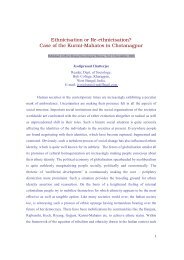Chapter 5 - WebRing
Chapter 5 - WebRing
Chapter 5 - WebRing
You also want an ePaper? Increase the reach of your titles
YUMPU automatically turns print PDFs into web optimized ePapers that Google loves.
CHAPTER 5. MAGNETIC SYSTEMS 233<br />
and the isothermal susceptibility χ, which is defined as<br />
<br />
∂M<br />
<br />
χ = . (5.10)<br />
∂B T<br />
The susceptibility χ is a measure of the change of the magnetization due to the change in the<br />
external magnetic field and is another example of a response function.<br />
We will frequently omit the factor of µ in (5.9) so that M becomes the number of spins<br />
pointing in a given direction minus the number pointing in the opposite direction. Often it is more<br />
convenient to workwith the mean magnetization per spin m, an intensive variable, which is defined<br />
as<br />
m = 1<br />
M. (5.11)<br />
N<br />
As for the discussion of the heat capacity and the specific heat, the meaning of M and m will be<br />
clear from the context.<br />
We can express M and χ in terms of derivatives of lnZ by noting that the total energy can<br />
be expressed as<br />
E = E0 −MB, (5.12)<br />
where E0 is the energy of interaction of the spins with each other (the energy of the system when<br />
B = 0) and −MB is the energy of interaction of the spins with the external magnetic field. (For<br />
noninteracting spins E0 = 0.) The form of E in (5.12) implies that we can write Z in the form<br />
Z = <br />
e −β(E0,s−MsB) , (5.13)<br />
where Ms and E0,s are the values of M and E0 in microstate s. From (5.13) we have<br />
∂Z<br />
∂B<br />
and hence the mean magnetization is given by<br />
M = 1 <br />
Mse<br />
Z<br />
−β(E0,s−MsB)<br />
s<br />
<br />
= βMse −β(E0,s−MsB) , (5.14)<br />
s<br />
= 1<br />
βZ<br />
s<br />
∂Z<br />
∂B<br />
If we substitute the relation F = −kT lnZ, we obtain<br />
(5.15a)<br />
∂lnZN<br />
= kT . (5.15b)<br />
∂B<br />
M = − ∂F<br />
. (5.16)<br />
∂B<br />
Problem 5.2. Relation of the susceptibility to the magnetization fluctuations<br />
Use considerations similar to that used to derive (5.15b) to show that the isothermal susceptibility<br />
can be written as<br />
χ = 1<br />
kT [M2 −M 2 ] . (5.17)<br />
Note the similarity of the form (5.17) with the form (4.88) for the heat capacity CV.

















